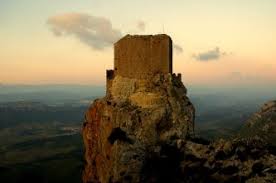In Les Corbieres dry stone walling is a lost art that needs reviving. Well that’s my locked down opinion anyway. Stuck at home,due to the coronavirus lock down here in France, and unsure when the markets will be back, the mad Spring planting rush is a little less rushed than usual. What are we going to do with 5,000 tomatoes if we can’t sell them, anyone fancy 1,000 Basil plants?- no didn’t think so.So I have time on my hands to learn a new skill, why not dry stone walling?.
Les Corbieres is littered with old falling down dry stone walling. It goes back to the time when land, particularly pasture land was scarce. Terracing in particular, was used extensively to increase pasture land on the hilly terrain, but also as a way to avoid soil erosion and provide a foothold for olive trees, to channel and prevent flooding from water flows and to provide domestic animal barriers at the edge of pastures.
The slow decline of the agricultural Corbieres has seen our stone walling fall into disrepair. A combination of weather, neglect and wild boar damage has left few intact. With less than 5% of the land in our immediate area now in agricultural use, and that the most accessible to mechanical cultivation, their is little use for this old farmer’s skill.
The Domaine de Montrouch has gone through a number of transformations in it’s long history. From fortified agricultural hamlet, to crusader strong hold, back to subsistence farm, then in the 1970’s as a bergerie, a shepherds property, to nowadays an organic aromatic herb small producer. In that history the land around it has been terraced, animal enclosures constructed, defensive walls been build, even during the crusader occupation a tower being built.
The land immediately surrounded the house, and the hillsides and fields are littered with traces of stone walling in various staged of disrepair.
So with cabin fever setting in I pulled Andy Radford’s “A Guide to Dry Stone Walling” off the shelves, blew the dust and cobwebs off it- and pour myself a large glass of wine.
Now I’ve done a bit of dry stone building here, mainly to build a terrace, but that was really just piling rocks on top of one another and topping with a concrete slab, by the grace of God it hasn’t fallen down- yet. It is so covered with plants that nobody can see how ramshackle it is.
The small bit of walling off flower beds I have done is mainly cosmetic, low level, and immanently susceptible to being wrecked by visiting wild boar, who love to trun over rocks to eat the worms and crawly beasts to be found beneath.
Reading Andy Radford’s book, really helped me to get my head around the importance of a solid foundation, grading stone, with the larger stones forming the base, how to pin facing stone in place, facing being outward looking stone, back filling, and topping the structure correctly. Most importantly is how to prepare properly, getting the right tools in place, making a clear plan, rather than making it up as you go along. Also key is getting the materials, that is the stone, organised into size, and usage, base, intermediate, through stone, coping, (topping stones) and pining and rubble. Doing this properly takes time but ultimately it makes for a much easier work flow, and a faster construction process.
I have started on a “small” project, building terrace wall at the entrance to our garden, start at a height of 80cms, to a peak of about 2 meters, around 3 meters length, with sides to close in a old twisted old juniper tree and provide a bed for tumbling Rosemary to fall down the wall. Once I have worked out how to get pictures from my camera onto my newly up dated windows laptop I will post the progress so far.
The lessons learnt so far, dry stone walling basics are simple, the practice is not. It is one of those activities, like organic herb growing, that the more you do it the more your understand how little you know, and how much more there is to learn. Secondly, there is no rushing it, after spending two hours this afternoon building and taking down the highest corner to ensure it was as solid as possible, trying to do things at speed is a false economy of time.
Dry stone walling is however very pleasurable, I am sure I will look back at this first serious attempt with grave embarrassment but at the moment I feel suitably proud of myself.
A Dry Stone Walling practitioners association, the forum is full of useful tips, photos and ideas



I’d love to have a go at dry stone wall building. Unfortunately, stone isn’t as easy to come by in our bit of the French countryside and I’d either have to buy it (too expensive) or rob it from someone else’s wall and there aren’t many of those left nowadays! 🙂
Hiya Ella, post war many of the countrysides walls dismantled, and hedges were cut down, to allow for easier mechanical access for cereal growing. I think it was a real loss. No shortage of stone down here in Les Corbieres. Hope you are both well. Love Pete and Caroline